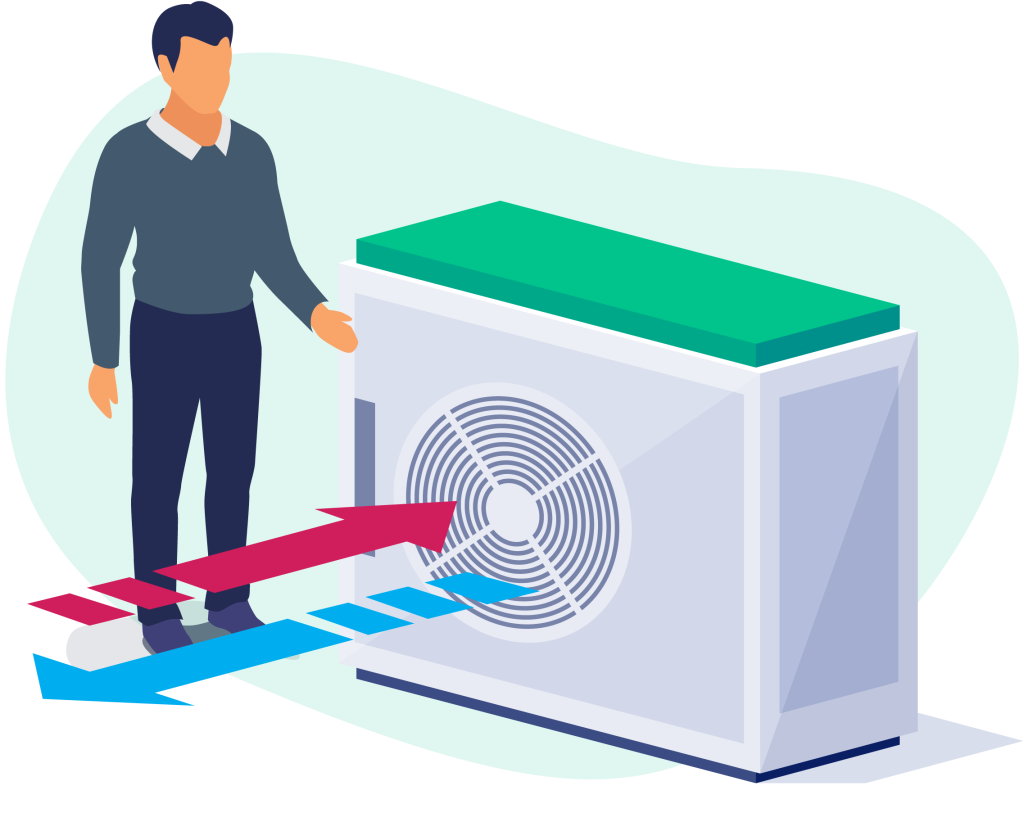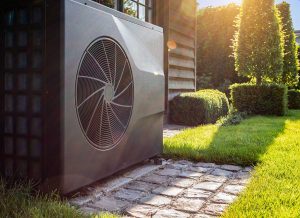Domestic Insulation

Insulation
Info about insulation - rest of this page needs to be edited.
How Does an Air Source Heat Pump Function?
The system draws heat from the outside air into a fluid, which then passes through a heat exchanger within the pump. This process increases the temperature of the fluid, which is then used to heat water for your home.
Is an Air Source Heat Pump Right for My Home?
Air source heat pumps are adaptable to various home types and are the most widely installed heat pump system in the UK, with tens of thousands of homes already using them. To find out if this technology is suitable for your home, you can use our online tool, Go Renewable, to assess your options.
Types of Air Source Heat Pumps
Monobloc Systems
All components are contained in a single outdoor unit, with water pipes connecting to your home’s heating system and hot water cylinder.
Split Systems
The components are split between outdoor and indoor units.
Choosing between a monobloc or split system depends on factors like your budget and available space. Monobloc systems are usually less expensive and easier to install but may be slightly less efficient. Split systems can be more efficient since some heat transfer occurs indoors, where heat loss is minimized.
Space Considerations for an Air Source Heat Pump
You'll need an outdoor space where the unit can be mounted on a wall or placed on the ground with adequate clearance for airflow. If you have sufficient indoor space, a split system might be a worthwhile investment despite the higher cost. Your installer can help you determine the best setup for your home.
What if I Lack Outdoor Space?
If you live in a flat or a home without outdoor space, compact heat pumps are available that fit small, well-insulated areas. These units require only a cupboard-sized space near an exterior wall. Alternatively, an air-to-air heat pump could be suitable, especially for smaller properties like park homes or flats. For flats with shared services, communal heating solutions may also be an option.
How is Hot Water Stored with a Heat Pump?
Unlike combi boilers, standard heat pumps don't provide on-demand hot water, so you'll need a storage solution like a hot water cylinder. The size of the cylinder will depend on your household’s hot water needs and can typically fit into a cupboard with at least 80x80cm of space.
Additional Hot Water Storage Options:
- Hybrid Systems: These combine a heat pump for heating with a boiler for on-demand hot water.
- Heat Batteries: More compact than traditional hot water cylinders.
- Instantaneous Hot Water Heaters: These can be installed under a sink to provide smaller amounts of hot water.
Why Opt for an Air Source Heat Pump?
Considerations for Installing an Air Source Heat Pump
Before installation, consider these factors:
- Installation Costs: Typically around £14,000, though funding may be available depending on your location.
- Space Requirements: Not all homes have enough space for a standard air source heat pump and hot water cylinder, but there are options for smaller homes or those without outdoor space.
Cost of Air Source Heat Pump
Installation costs vary based on factors such as:
- The size of the heat pump.
- The size of the property.
- Whether it's a new build or an existing home.
- The need for adjustments to your heat distribution system.
Running costs will depend on how your heat pump is designed and operated. Savings on your energy bills will vary depending on the system you’re replacing and other factors like radiator size and electricity tariffs.
Available Funding
As of October 23, 2023, the UK Government’s Boiler Upgrade Scheme has increased the heat pump grant to £7,500 for both air and ground source heat pumps. Installation costs for air source heat pumps range from £2,400 to £14,050, with average prices between £6,500 and £11,500. Annual operating costs vary between £685 and £1,550, depending on the size of your home and your energy needs.
Commercial CHP Systems in the UK and Scotland
Combined Heat & Power Systems (CHP)
CHP Energy Systems in the UK
Electricity in the UK is typically generated at power plants with about 40% efficiency, which decreases further due to transmission losses by the time it reaches consumers. Combined Heat and Power (CHP) systems generate electricity on-site using a gas-powered engine, which also produces heat that can be used for the facility. This localised electricity generation can achieve up to 90% efficiency, significantly reducing the carbon footprint of the heat and power used on-site.
Types of CHP Installations
CHP systems vary depending on the end user’s needs:
- Large Commercial CHP Installations: These systems use steam and gas turbines to generate electricity and heat on industrial sites with a constant, high energy demand. Modern systems can synchronize with the national grid, allowing surplus electricity to be sold back to the grid.
- Medium CHP Installations: These systems use gas-powered engines to generate electricity on sites like hotels and leisure complexes. The excess heat can be utilized where there is a high demand, such as swimming pools.
- Small CHP Installations: As technology advances, smaller units known as micro-CHP are becoming available. These include small-scale gas engines, fuel cells, and gas boilers with a Stirling engine, which can generate up to 1kW of electricity when the boiler is operating.
How CHP Systems Work
CHP, or Combined Heat and Power, is a highly efficient process that captures the heat produced during electricity generation and repurposes it for additional power or heating. This dual-generation approach can reduce carbon emissions by up to 30% compared to traditional methods that use separate systems for heating and electricity.
Benefits of CHP for Businesses
CHP systems offer multiple benefits:
- Cost Savings: CHP systems consume less energy than conventional methods, potentially saving up to 40% or more on energy costs due to on-site electricity generation.
- High Efficiency: By utilizing heat that would otherwise be wasted, CHP systems meet heating demands without requiring additional fuel.
- Reduced Carbon Emissions: CHP systems are more efficient than traditional energy systems, producing fewer greenhouse gases per unit of energy, making them an ideal choice for businesses focused on sustainability.
Commercial CHP Applications in the UK
CHP systems are versatile and can be applied in various commercial settings, including offices, retail developments, mixed-use areas, and district energy schemes. These systems have been successfully implemented in diverse environments, such as office buildings, airports, and shopping centres across Scotland and the UK.

Pro Tips
This guide is not only a pitch for business but a genuine attempt to help consumers navigate the misinformation surrounding heat pump installations. If you’re looking for a system with long-lasting efficiency, low running costs and minimal noise, here are the six red flags to avoid when considering a heat pump installation.
Red Flag 1 : Design Flow Temperature
If you’re being sold a heat pump with a flow temperature of 50C, be cautious. A higher flow temperature can limit the efficiency of your heat pump and shorten its lifespan. Some manufacturers offer a 7-year warranty, which is far shorter than the potential lifespan of a heat pump installed with the correct parameters.
The reason for this limited warranty is that manufacturers have no control over how the heat pump is installed, particularly concerning flow temperature. Many mass-market installations are designed for 50C flow temperatures, which can significantly reduce the lifespan of the compressor and increase noise levels. Additionally, for every degree increase in flow temperature, you may experience a 3% loss in efficiency. A heat pump designed with a 35C flow temperature can be up to 45% more efficient than one designed for 50C.
Lowering the flow temperature naturally enhances efficiency, reduces running costs, extends the lifespan of your heat pump and minimises noise. Always question any company promoting flow temperatures above 45C.
Red Flag 2 : Different Room Temperatures Designs, Pros and Cons
CIBSE design guides recommend different temperatures for different rooms, such as 18C for kitchens and 21C for living rooms. However, designing emitters for varying temperatures in adjacent rooms can lead to inefficiencies. But in our opinion, this gives a better everyday living experience, with minimal inefficiencies losses.
To achieve the absolute efficiency your home should be designed with a single consistent temperature, with a setback temperature for cooler bedrooms overnight. According to thermodynamics, heat will always move from hot to cold areas. This means that the warmer room will lose heat to the cooler room, causing your system to become unbalanced and your heat pump to work harder than necessary. It’s nearly impossible to maintain exacting different temperatures in different rooms unless they’re vacuum-sealed. Always question any company that doesn’t explain this difference of the benefits and drawbacks of using one consistent design temperature across your entire property.
Red Flag 3 : Third Party Controls, Zoning & TRVs
Imagine a simple two-up, two-down house, where each room has a 2.5kW heat loss/load, totalling 10kW for the entire house. If you install a 10kW heat pump and then zone the house into upstairs and downstairs, shutting off the upstairs zone during the day, you’ve essentially halved the water volume in the system. This reduction in water volume can cause your heat pump to cycle on and off, reducing efficiency and potentially shortening its lifespan.
Heat pumps operate most efficiently when they can modulate their power to maintain a steady temperature. However, third party ‘smart’ heating controls often act like on/off switches, which can cause the compressor to cycle inefficiently. These controls were originally designed for combustion heating (boilers) and are not ideal for vapour compression heating (heat pumps).
The best approach is to use weather compensation controls, which allow your heat pump to adjust its power output based on outdoor temperatures, maintaining a consistent indoor temperature without cycling the compressor. Always question any company that suggests using third party or ambient controls.
Red Flag 4 : Buffers, Hydronic Separation & Fixed Speed Circulation Pumps
In 99% of the UK housing stock buffers are not necessary. A buffer is essentially a cylinder of water connected to both the heat pump and the central heating system. The use of a buffer with a fixed speed circulation pump and third-party controls leads to huge inefficiencies. The circulation pump on the heating side of the buffer will work at a different speed to the circulation pump inside the heat pump causing distortion across the buffer.
Most heat pumps are designed to operate with a temperature differential (ΔT) of 5C between the flow and return. However, when a buffer is used, the differential on either side of the buffer can become different. This means the heat pump may have to work harder to reheat more than 5C. This can result in huge inefficiencies and reduce the life of your heat pump.
Buffers are often used by installers to simplify the installation process, but this can lead to a lazy and inefficient system. If you really need additional system volume to reduce cycling, consider a volumiser. This is essentially the same tin can as a buffer but ideally sits in line on the flow pipe from the heat pump. This adds system volume without the need for hydronic separation.
However, it’s worth nothing that a well-designed system at a low flow temperature with the correct sized heat pump, pipework and emitters will have enough system volume that you most likely do not need to install either a buffer or a volumiser.
If your designer/salesperson is specifying either of these things, ask them to prove why they are needed. Put simply, buffers massively reduce efficiency and make your system more costly to run.
Red Flag 5 : Central Heating Pipe Sizing
Proper pipe sizing is crucial for the efficient operation of your heat pump. The designer should always be able to provide calculations to ensure that your house’s pipework is capable of transporting the full power output of the heat pump. If the pipework isn’t large enough, upsizing radiators will be pointless, as the energy won’t be able to reach them efficiently.
A good designer will consider this and prove their design mathematically, leaving nothing to guesswork.
Red Flag 6 : Power Output Size of the Heat Pump
The heat pump you choose should be matched to the specific heat loss of your home. If the heat pump is oversized, it will cycle on and off, leading to inefficiencies and potential damage. On the other hand, if it’s undersized, it will overwork and struggle to maintain the desired temperature, especially in colder weather.
As a crude example, if your heat loss is 3.8kW and you are being sold a 6.9kW heat pump, this heat pump is probably oversized and will potentially cycle.
Proper sizing is essential to ensure that the heat pump operates efficiently and lasts as long as possible.
Closing Thoughts
These are the six red flags to watch out for when purchasing a heat pump. We at Town and Country Renewables are passionate about sharing our knowledge to push the industry in the right direction. We want consumers to be empowered to ask the right questions and choose a system that works efficiently, doesn’t cost a fortune to run and lasts a long time.
